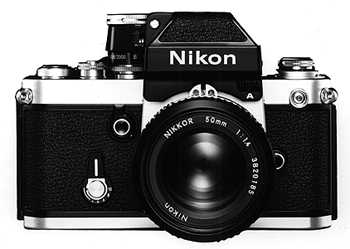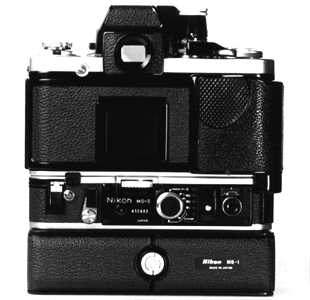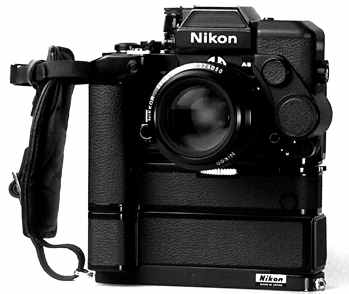| The F-Series |
Nikon F2 |
| During the 60`s, especially in the USA, the Nikon F slowly developed from an insider's tip to the number one professional camera. In Europe, though, the F remained rather unknown until the end of the 60`s. It was the F`s successor, the Nikon F2, that achieved the breakthrough in Europe. Introduced in 1971, it was in general a further developed F. |
 |
| The classic F of the 70`s: the Nikon F2A with a Nikkor 50mm, f/1.4 |
| The body has rounded edges and fits into the hand even more snugly. The basic construction remained almost identical to that of the F, but some design details were changed and improved. The film advance lever operates with a single 120° stroke and switches on the exposure meters in the new Photomics at the 20° position. The shutter release button was moved further towards the front edge of the camera allowing easier control, but the collar located around it has different functions compared to the Nikon F. Turned to the right to ''L'', the shutter can be secured against accidental release, in the opposite direction to ''T'', time exposures can be made in combination with the B-setting of the shutter speed dial. This function comes in handy when, for example, no cable release is available. Pressing the release button trips the shutter and setting the collar back to the normal position terminates the exposure. |
| The F2 has a fastest shutter speed of 1/2000 sec. This was achieved by reducing the running time of the blinds to 10 ms as well as reducing the width of the slit. This also resulted in a faster synchronization speed of 1/80 sec. The attachment system for the finder remained the same as in the F, so that focusing screens and finders, with the exception of the Photomics, are compatible. |
| Another major difference between the two series of metering finders should be mentioned. Whereas the power supply for the F-type Photomics is situated within the finders themselves, in the case of the F2 it was moved to the bottom of the camera. Two contacts to the left and right of the F2-Photomics facilitate the neccessary connection to the two batteries in the camera. |
 |
| The F2 with the Motor drive MD-2, directly connecting battery compartment MB-1, and the stop-back MF-3 |
|
The F2`s rewind crank can be pulled up out of the body by about 6mm so that the film can be wound back much faster and easier,
while the accessory shoe beneath the crank is identical to that of the F. The first two digits of the serial number are
the date of manufacture.
In order to improve durability for everyday professional work the bayonet and the shutter parts subject to heavy strain are made of a chrome-nickel-steel alloy. In addition, tiny ball-bearings within the shutter mechanism contribute to its precise functioning. Compared to the F, the mirror is longer, to avoid vignetting in the viewfinder when using very long telephoto lenses or lens extensions such as bellows attachments. The depth-of-field preview button is located in the same place as on the F, concentric with it is the mirror lockup lever which now works independently of the shutter function and therefore without the cost of one frame, unlike the F. The self-timer has its own release button similar to the F. The T-position, however, opens up additional possibilities: if the shutter speed dial is simultaneously set to ''B'', long exposures from 2 to 10 seconds can be controlled with it. The camera back is hinged in what is now the usual manner. Even so, it can be removed so that the bulk film backs for 250 or 750 exposures can be mounted. The special MF-3 model was available with a back which prevents the film leader from disappearing into the cartridge when the motor drive MD-2 is employed to rewind the film. In continuous mode the MD-1 and MD-2 motor drives are capable of accelerating the F2 to speeds of 4 and even 5 frames/sec. if the mirror is locked in the up position. The motor`s performance in reverse is also remarkable; it can rewind a 36-exposure film completely into the cartridge in a mere 7 seconds, a feature much appreciated by press photographers. |
 |
| A rare combination: the F2 AS with a 50mm,f/1.2 Nikkor, motor drive MD-3/MB-2, DS-12, and the grip strap AH-1. |
|
The back of the camera is opened by turning a catch recessed into the base-plate, which has to be removed when a motor
drive MD-1 or MD-2 is mounted in order to allow the rewind-spindle access to the cartridge. Since such a small part
could be easily lost, a place to store this O/C-key was provided in the grip section of the motor. Because of this
need to unscrew the catch, a motor should only be mounted or removed in subdued light, or when there is no film in the
camera because of the possibility of light entering the cartridge compartment through this hole. The motor drive
coupling is located on the opposite side of the base-plate together with the rewind release button and the motor
drive release coupling.
In spite of the different versions and except for internal detail modifications, the body of the F2 remained practically unchanged throughout its production life. The exposure metering finders, the Photomics, on the other hand were updated as technical developments allowed. It was this system as a whole, consisting of viewfinders, motor drives, focusing screens, camera backs and of course the lenses that made Nikon a synonym for professional 35mm-photography. If the versatility and adaptability of the standard F2 to the widest range of tasks was still not enough, one of the special versions will have done the job. |
| back to Nikon COMPENDIUM main page |